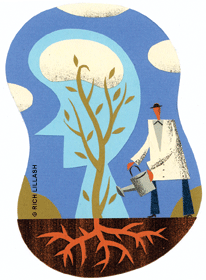
Benefits of Neighborhood Cleanup Go Beyond Beauty
Community-based investments such as trees, cleaned-up vacant lots, and business-improvement districts (BIDs) do more than just make urban residents feel warm and fuzzy about their neighborhoods. They also provide significant economic benefits, and can raise property values as much as 25 percent.
And by increasing property-tax revenues, those investments can boost the economy of a city, according to a recent study by Dr. Susan Wachter (professor of real estate, finance, and city and regional planning) and Kevin C. Gillen (research fellow at Penn’s Institute of Urban Research).
“While it is well understood in principle that investments in blighted areas raise property values and overall neighborhood quality, our research quantifies these benefits,” note Wachter and Gillen in “Public Investment Strategies: How They Matter for Neighborhoods in Philadelphia.”
By merging information from the city’s Board of Revision of Taxes, sales-price data on 200,000 property sale-price observations from 1980 to 2004, “social-outcome” data on neighborhood crime rates and school quality, “greening data” (such as new tree plantings and streetscaping), and other sources, Wachter and Gillen found:
• While the noise and congestion that comes from being near a commercial corridor usually will lower housing prices, that economic effect is reversed if the corridor is in “excellent” or “good” condition. Corridors in “excellent” condition are correlated with a net increase in value of more than 20 percent for homes within mile of the corridor and a 10-percent net rise for those within mile.
• A cleaned-up vacant lot with new trees, benches, and fences increases the value of homes by 17 percent, whereas a neglected vacant lot subtracts an average of 20 percent.
• Streetscaping projects (usually along commercial corridors) that include tree and container plantings, small pocket parks, parking-lot screens, and median plantings can increase nearby home values by
28 percent.
• Homes located in BIDs, which provide maintenance, safety, and marketing services to neighborhoods, are valued 30 percent higher than comparable homes not located in BIDs.
• Higher crime rates are associated with lower home values “on the order of about minus-14 percent for every one percent increase in the overall crime index.”—S.H.
Now It’s Matter, Now It’s Not
The exotic particle known as Bs meson (pronounced B sub s meson) oscillates between matter and antimatter, and it does so very, very rapidly: at a rate of 3 trillion oscillations per second, in fact. While physicists have known of its possible existence for some 20 years, it took a team of 700 physicists at the Collider Detector at Fermilab (the Department of Energy’s Fermi National Accelerator Laboratory in Batavia, Illinois) two decades to develop the experimental sensitivity to measure the actual oscillation rate.
Last April a precise measurement was finally confirmed, thanks in large part to Dr. Joseph Kroll, professor in the Department of Physics and Astronomy. By October, the physicists were able to refine their data-analysis techniques to reduce the probability of a statistical fluctuation to eight in 100 million—well within the accepted standard of proof.
Kroll, a lead author of the report submitted to Physical Review Letters, headed the proposal for the Time-of-Flight detector, which proved to be key to the successful measurement. Though he encountered some initial resistance to the project, he says he and his team were able to overcome it by “building a solid case.” Kroll was also instrumental in putting together the devices used to detect Bs meson and observe its oscillations.
The physicists measured the rate of the matter-antimatter transitions for the Bs meson, which consists of the heavy bottom quark bound by the strong nuclear interaction to a strange antiquark.
“The measurement of this frequency of particle-antiparticle transformations allows us to measure fundamental parameters in our Standard Model of particle physics in a way we couldn’t before,” says Kroll. “This measurement can be used to shed light on the existence of particles” not currently contained in the Standard Model.
Having been focused on this measurement for most of the past decade, Kroll describes himself as “incredibly lucky,” adding: “To be able to see a project like this to fruition doesn’t happen very often.” —S.H.
Stretch Nerves After They Snap

Traumatic brain and spinal-cord injury, which affects an estimated two million Americans every year, is the worst kind of stretching—a sudden, violent tearing-apart of axons, the delicate fibers or “jumper cables” that allow nerve cells to communicate.
“They’re like the canary in the mine, the most fragile component in the brain,” explains Dr. Douglas Smith, professor of neurosurgery and director of Penn’s Center for Brain Injury and Repair. Although axons can easily accommodate the normal jiggling of brain matter that occurs when we’re moving around, greater forces—such as those sustained in a car accident—can snap them. “Your brain is not evolved to tolerate that,” he points out.
So far the primary treatment has been to bridge the damaged areas with transplanted axons to provide a framework upon which nerves can re-grow—if surgeons can obtain enough long axons. Even then, natural inhibiting mechanisms usually work against regeneration.
Several years ago, while studying how axons are damaged by sudden stretch in traumatic injury, Smith noticed that axons actually grow under tension in certain circumstances—in the long spinal cords of blue whales and giraffes, for example. Maybe, he thought, axons could be mechanically induced to grow across a gap, like engineers bridging a river.
“I call it the missing chapter in neuroscience,“ he says. “People haven’t studied how axons grow. Nobody’s ever experimentally explored it.”
Smith and his research team did. First they placed neurons on plastic plates coated with cell nutrient and put the plates next to each other. Soon axons popped up and connected with their fellows on the other plate. When the plates were slowly and gradually pulled apart—using precise, computer-controlled “microstepper” motors—Smith found that the axons weren’t thinning out; instead, they were growing, adding new material, under the mechanical tension. On the “rack,” Smith managed to grow axons from a starting length of 100 microns (about the width of two human hairs) to 10 centimeters in less than two weeks, with the cells surviving for months afterward.
Smith has transplanted stretched axons into rat spinal cords by embedding the fragile stretched fibers in a collagen membrane to preserve their delicate geometry, creating what he calls “a fruit roll-up” that can then be moved into the damaged area. The new axons not only survive but continue to grow after transplantation. The next step for Smith and his team is to find out whether the transplanted axons can still transmit electrical signals and perform their jumper-cable function. If so—and if it works in humans—the implications could be far-reaching.
Although Smith is reluctant to make any promises— “Science is slow,” he emphasizes—successful clinical trials could lead to important new treatments.
—Mark Wolverton

